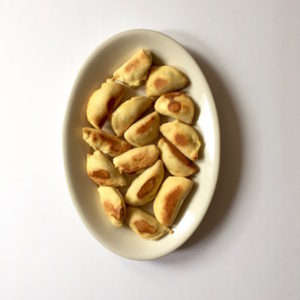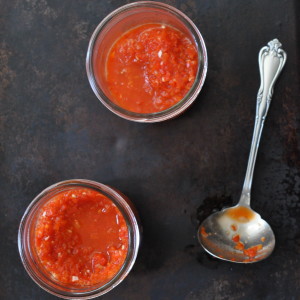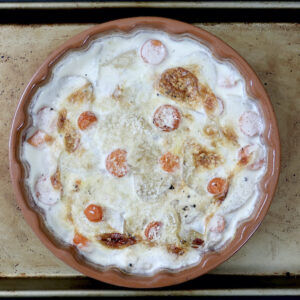Chicken with bacon, olives, and tomato sauce
Another blogger would be posting all kinds of holiday recipes now, specifically Chanukah recipes, as the first night is but four days away, and I am a fully-fledged member of the tribe.
But…
I’m going to assume you neither need nor want another recipe for challah with cilantro or latkes with cranberries. I’m going to crawl even further out on a limb and admit I am not fond of updated Ashkenazi recipes. My Lithuanian forebears did not have access to rosewater, figs, or cumin seeds, all ingredients I’ve seen suggested recently in Chanukah recipes for Ashkenazi foods (broadly, Ashkenazi Jews hail from Eastern Europe.) These are all lovely ingredients. None are faintly Ashkenazic.The food of my people is bland, heavy, filling. You leave the table knowing you’ve eaten. Further, you feel that way for hours. This is not, in context, a bad thing.
Ah, context, bugbear of English Ph.D programs everywhere. Ashkenazi food in context, briefly: It is helpful to partake of food prepared by an excellent cook, like my deceased grandmother. It is helpful if the weather outside hovers around 0 degrees Fahrenheit. It is extremely helpful if every dish save dessert has been prepared using mountains of chicken fat.
Context, as participants in English Ph.D programs can attest, is difficult. That’s why there are no latke recipes here. Let’s talk about chicken instead. In fact, really treyfe (nonkosher) chicken, with a little bacon tossed in.
This beautiful recipe is adapted from Paula Wolfert’s Mediterranean Cooking. It’s a classic Paula, exemplifying what she calls “the big taste”. Here, that means the best parts of Southwestern French cuisine–that treyfe bacon, garlic, tomatoes, olives, olive oil, chicken stock–get folded into one big dish.
Wolfert’s recipes have a reputation for fussiness. The duck confit recipe in The Cooking Of Southwest France is three pages long. The Slow Mediterranean Kitchen’s Night And Day Slow-Roasted Pork Shoulder takes 12 hours to cook. Many of Wolfert’s stews take two or three days to prepare. Yet the work itself, while time-consuming, is seldom difficult. My favorite Wolfert recipes tackle tough, inexpensive cuts of meat, cooking them until they’re silky and sumptuous. As for time, those cooks unable or unwilling to spread a recipe over three days need not: a stew may be cooked in an afternoon.
Whatever path one takes when approaching a Paula Wolfert recipe, the experience of cooking is on a par with consuming the inevitably wonderful result. To cook under Wolfert’s tutelage, her book open beside you, is to absorb more than you realize. Apprentice yourself to Wolfert’s books and learn all the ways a little pork can flavor a dish, everything about confit, the most economical ways with duck. How to coax flavor from uninspiring bits. How to make cassoulet. How to choose a bottle of Armagnac. What to do on a cold night with a package of chicken thighs.
Chicken with Bacon, Olives, and Tomato Sauce
Adapted from Paula Wolfert’s Mediterranean Cooking
Serves: 2-4
Cooking time: approximately 1 hour 20 minutes
2 pounds bone-in, skin-on chicken thighs
3 tablespoons olive oil
1/2 cup slab bacon, diced
1/2 medium onion, diced
2-3 large garlic cloves, minced
1/2 cup dry white wine or Vermouth
1 shot Armagnac (optional)
1 15-ounce can crushed tomatoes
1 cup chicken stock, low salt if canned
3 tablespoons parsley, chopped
1 bay leaf
1/4 teaspoon fresh thyme (optional)
pinch cayenne
24 olives-Gaeta, Kalamata, or Picholine, pitted and lightly chopped
salt and pepper
Preheat the oven to 325 F.
An hour before cooking, take the chicken from the fridge and allow it to come to room temperature.
If possible, season the chicken with one teaspoon salt, 2 days to 1 hour ahead of cooking. If not possible, salt and pepper the chicken when you cook it.
Heat the olive oil in a large skillet and brown the chicken. Begin with the skin side down, about four minutes, then flip. The skinless side will need just a couple minutes. This is not the time to check text messages.
Have a 3 1/2 or 4 quart heavy casserole beside you on the stove. Pour a little olive oil into the casserole and turn the burner to the lowest heat.
While you can brown the chicken in the casserole, I’ve had problems with enameled cast iron surfaces scratching when browning and scraping up drippings. I feel more confident working with stainless skillets and transferring the chicken to the casserole.
Brown the chicken in the skillet without crowding. If anything burns, remove it from the skillet (another good reason to work here instead of in your nice expensive casserole). Transfer chicken to the casserole as it browns.
If you are using the Armagnac, add it to the pan now and ignite with a long match. Please do not set yourself or anything besides the Armagnac aflame. While it burns, call your significant other and tell him/her how much fun you’re having flaming French brandy. If you are single, pretend you’re Beavis (or was it Butthead?) and exclaim fire! fire! while your cat gives you the “humans are crazy” look.

Once the flames have died down, resume adult behavior. Add the bacon, onion, and garlic to the pan, and give everything a stir. Add the white wine or Vermouth, turn up the heat, and cook until the wine evaporates.
Now add the tomato sauce, chicken stock, half the parsley, the bay leaf, thyme, and cayenne. Let it all find itself for a moment, and then tip it–carefully, please–into the casserole.
Place a lid on the casserole. Lacking a lid, cover it with foil, tuck it into the oven, and go about your business for the next hour.
Once the hour is up, remove the lid from the casserole and add the olives. The chicken should need about 20 more minutes, but check. It’s done when cooked through completely–no pink– and pulls easily from bone with a fork.
Note: I am married to a person who is not fond of onion, and must cook accordingly. Feel free to increase the amount of onion in this recipe to 1/2 cup, chopped.

Add the rest of the parsley. Eat with lots of bread to sop up the juices.





